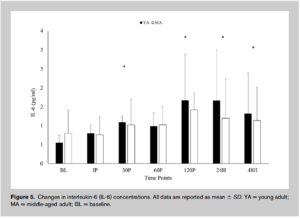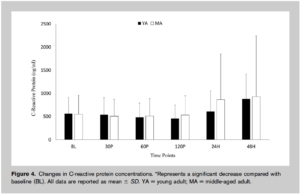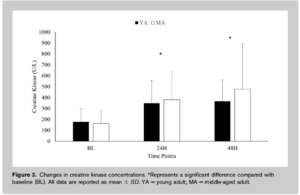Do we recover slower as we age?

Most of you know that Dave and I place consistency in training above all else. In terms of having a very specific plan, while important, this is lower down the list. In fact, I’m finding myself more of a generalist in my own training, leaning on variety to stave off boredom.
Most recently I’ve been doing a classic “meathead” style 5 x 5 resistance training program where on lifting days I do 5 sets of 5 heavy repetitions of just 3 big movement exercises like squats, deadlifts, chest presses, pull ups and overhead lifts. It’s been fun acting like a 20 year old in the gym again, but I’m noticing something that’s been a bit alarming.
I’M ALWAYS SORE!
I’m sore going down stairs, I’m sore getting in and out of my car…..I’m even sore lifting and carrying my kids.
Is this all in my head or is this a byproduct of me nudging closer to 40 years old.
Lucky for me there is an article that answered this exact question for me from the Journal of Strength and Conditioning Research.
We know getting older sucks. As we age, it has been established that we get decreases in muscle mass, function and even neuromuscular activation. But it turns out that essentially all of this research is on adults over the age of 60. While it has been shown that recreationally trained adults in their late 60’s do have impaired recovery compared to younger adults, there is no compelling research for middle-aged folks (age 40-59). That is exactly what this study looked at.
The study was simple. It looked at the recovery response from a single acute high volume weight workout in young adults aged 18-30 and compared it to middle aged adults aged 40-59. Because the definition of ‘recovery’ is not settled, this study used a variety of different outcome measures to see how each group fared.
The study participants for each group had to already by performing resistance training at the American College of Sports Medicine recommended 150 minutes weekly for the prior 6 months.
On the study day, participants had to fast for 10 hours then had a variety of measures taken including a blood sample, a quadriceps muscle ultrasound, body measurements such as weight and height, and self rated pain and soreness. Next, they performed a single maximal muscle test for their quads where they essentially did a single leg extension exercise as hard as they could. After a 5 minute rest they then performed the “high volume resistance protocol” which was a grueling 8 sets of 10 repetitions of single leg quadriceps extensions with heavy weight. Finally, they repeated the maximal contraction test and went through the same measurements (blood sample, ultrasound etc) right away, at 30, 60, 120 minutes, 24 hours and once more at 48 hours.
You may wonder why they use a single leg extension exercise only. It turns out this is commonly used in research as it is easy to perform, easy to standardize, and has been previously shown to induce lots of muscle damage.
The results?
While the young adults performed better on the strength measures as expected, there were essentially no differences in any measures of recovery.
Yes you read that correctly. Not on the ultrasound, not on strength returns to baseline, not even on any of the blood measures as shown in the 3 charts below:



These results mean there were no differences between the groups on inflammation OR any other muscle damage responses to the acute exercise protocol.
The study did confirm that the decline in strength we see does indeed appear by middle age. That said, in the words of the researchers “these results also suggest that middle aged recreationally active men who regularly engage in resistance training do not seem to be at increased risk for greater soreness or muscle damage in comparison with younger recreationally trained men.”
Just like the man flu, it appears my perceived post workout pain is all in my head.
